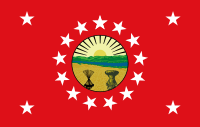George Hoadly
| George Hoadly | |
|---|---|
 | |
| 36th Governor of Ohio | |
|
In office January 14, 1884 – January 11, 1886 | |
| Lieutenant | John G. Warwick |
| Preceded by | Charles Foster |
| Succeeded by | Joseph B. Foraker |
| Personal details | |
| Born |
July 31, 1826 New Haven, Connecticut |
| Died |
August 28, 1902 (aged 76) Watkins Glen, New York |
| Resting place | Spring Grove Cemetery |
| Political party | |
| Spouse(s) | Mary Burnet Perry |
| Children | three |
| Alma mater | |
| Signature |
|
George Hoadly (July 31, 1826 – August 26, 1902) was a Democratic politician. He served as the 36th Governor of Ohio.
Biography
Hoadly was born in New Haven, Connecticut, on July 31, 1826.[1] As the son of George Hoadley and Mary Ann Woolsey Hoadley, his birth name was "Hoadley", but he later dropped the "e".[2]
George Hoadly graduated from Western Reserve College and attended Harvard Law School, where his fellow students included Rutherford B. Hayes and John Howell. He then studied law with Charles Converse of Zanesville, followed by study with the firm of Flamen Ball and Salmon P. Chase. Upon attaining admission to the bar Hoadly practiced in Cincinnati, initially in partnership with Ball and Chase.
Hoadly was appointed as Judge of the Cincinnati Superior Court in 1851, 1859 and 1864. From 1855 to 1859 he was City Solicitor. Hoadly also taught at the Cincinnati Law School, and served as a trustee of the University of Cincinnati. Originally a Democrat, he joined the Republicans during the American Civil War because he was opposed to slavery and supported the Union. In the mid-1870s he broke with the Republican Party and returned to the Democratic fold.
In 1883 Hoadly was the successful Democratic candidate for Governor, and he served one term, January, 1884 to January 1886. During his term in office, the Cincinnati Riots of 1884 broke out over a case in which a jury gave a verdict of manslaughter rather than murder. Believing the case was an obvious murder, and upset with longstanding allegations of corruption in local government, members of the public concluded that the verdict was rigged. A riot ensued as Cincinnati residents attempted to locate and lynch the killer, and 45 to 50 people died during three days of unrest and violence before militia troops reestablished calm.[3] Hoadly was blamed by political opponents and some observers for allowing the riot to grow by being slow to react.
In addition to the Cincinnati Riot, Hoadly used the militia to end the Great Hocking Valley Coal Strike, earning criticism from workers upset that the militia was employed, and condemnation from mine owners, who argued that Hoadly should have used the militia sooner than he did. As a result of these controversies, Hoadly was an unsuccessful candidate for reelection in 1885.
Hoadly moved to New York City in 1887, where he continued to practice law. He died in Watkins Glen on August 26, 1902, and was buried at Spring Grove Cemetery.
Family
Hoadly was a descendant of George (Joris) Woolsey, one of the earliest settlers of New Amsterdam, and Thomas Cornell (settler)[4]
Notes
- ↑ "George Hoadly". Ohio History Central. Retrieved August 3, 2010.
- ↑ George Hoadley, The Encyclopedia of Cleveland History, accessed August 3, 2010
- ↑ "Cincinnati Courthouse Riot". Ohio History Central. Retrieved 2010-10-23.
- ↑ Trowbridge, Francis Bacon The Hoadley Genealogy: A History of the Descendants of William Hoadley of Branford, Connecticut, Together with Some Account of Other Families of the Name. 1894. Retrieved November 10, 2013
References
- Goss, Charles Frederic (1912). Cincinnati, the Queen City, 1788-1912. 3. Cincinnati: S J Clarke Publishing Company. pp. 670–679.
- Reed, George Irving; Randall, Emilius Oviatt; Greve, Charles Theodore, eds. (1897). Bench and Bar of Ohio: a Compendium of History and Biography. 1. Chicago: Century Publishing and Engraving Company. pp. 87–89.
External links
| Wikimedia Commons has media related to George Hoadly. |
![]() "Hoadley, George". Appletons' Cyclopædia of American Biography. 1900. [sic]
"Hoadley, George". Appletons' Cyclopædia of American Biography. 1900. [sic]
| Offices and distinctions | ||||||||||||||||||
|---|---|---|---|---|---|---|---|---|---|---|---|---|---|---|---|---|---|---|
| ||||||||||||||||||

